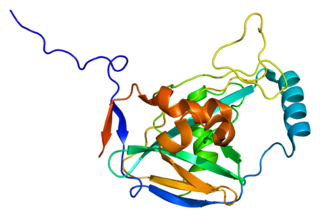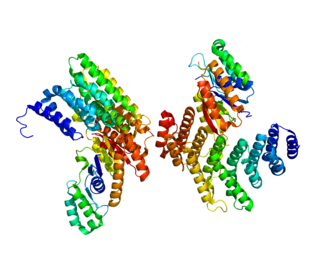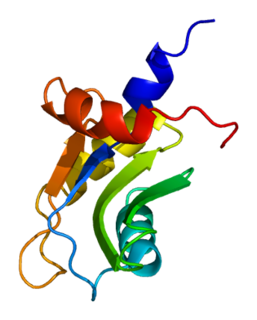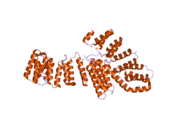Cleavage and polyadenylation specificity factor (CPSF) is involved in the cleavage of the 3' signaling region from a newly synthesized pre-messenger RNA (pre-mRNA) molecule in the process of gene transcription. It is the first protein to bind to the signaling region near the cleavage site of the pre-mRNA, to which the poly(A) tail will be added by polynucleotide adenylyltransferase. The upstream signaling region has the canonical nucleotide sequence AAUAAA, which is highly conserved across the vast majority of pre-mRNAs. A second downstream signaling region, located on the portion of the pre-mRNA that is cleaved before polyadenylation, consists of a GU-rich region required for efficient processing.

Eukaryotic transcription is the elaborate process that eukaryotic cells use to copy genetic information stored in DNA into units of transportable complementary RNA replica. Gene transcription occurs in both eukaryotic and prokaryotic cells. Unlike prokaryotic RNA polymerase that initiates the transcription of all different types of RNA, RNA polymerase in eukaryotes comes in three variations, each translating a different type of gene. A eukaryotic cell has a nucleus that separates the processes of transcription and translation. Eukaryotic transcription occurs within the nucleus where DNA is packaged into nucleosomes and higher order chromatin structures. The complexity of the eukaryotic genome necessitates a great variety and complexity of gene expression control.

5'-3' Exoribonuclease 2 (XRN2) also known as Dhm1-like protein is an exoribonuclease enzyme that in humans is encoded by the XRN2 gene.

DNA-directed RNA polymerase II subunit RPB4 is an enzyme that in humans is encoded by the POLR2D gene.

Splicing factor U2AF 35 kDa subunit is a protein that in humans is encoded by the U2AF1 gene.

Cleavage stimulation factor 64 kDa subunit is a protein that in humans is encoded by the CSTF2 gene.

Cleavage and polyadenylation specificity factor subunit 5 (CPSF5) is an enzyme that in humans is encoded by the NUDT21 gene. It belongs to the Nudix family of hydrolases.

Cleavage and polyadenylation specificity factor subunit 2 is a protein that in humans is encoded by the CPSF2 gene.

Cleavage and polyadenylation specificity factor subunit 1 is a protein that in humans is encoded by the CPSF1 gene.

DNA polymerase delta subunit 2 is an enzyme that in humans is encoded by the POLD2 gene. It is a component of the DNA polymerase delta complex.

Poly(A) polymerase alpha is an enzyme that in humans is encoded by the PAPOLA gene.

Symplekin is a protein that in humans is encoded by the SYMPK gene.

Cleavage stimulation factor 50 kDa subunit is a protein that in humans is encoded by the CSTF1 gene.

Cleavage stimulation factor 64 kDa subunit, tau variant is a protein that in humans is encoded by the CSTF2T gene.

Cleavage and polyadenylation specificity factor subunit 3 is a protein that in humans is encoded by the CPSF3 gene.

Cleavage and polyadenylation specificity factor subunit 4 is a protein that in humans is encoded by the CPSF4 gene.

Cleavage and polyadenylation specificity factor subunit 6 is a protein that in humans is encoded by the CPSF6 gene.

Integrator complex subunit 11 is a protein that in humans is encoded by the CPSF3L gene.

Transcription initiation factor TFIID subunit 9B is a protein that in humans is encoded by the TAF9B gene.

Cleavage and polyadenylation specificity factor subunit 7 is a protein that in humans is encoded by the CPSF7 gene.

























